| Feathers Blades, Cranks and Shafts |
|
Canoeist Magazine Articles |
| Feathers Blades, Cranks and Shafts |
|
Canoeist Magazine Articles |
a) - Introduction
b) - Blade Feather Angle
c) - Shaft Length
d) - Blade Area
e) - Cranks
e) - Conclusion
For many years, most people paddled kayaks which were all reasonably similar to each other in design and performance. Such General Purpose (GP) kayaks were about four metres long, much longer than todays short white water playboats.
Because nearly all types of kayak were longer and faster than they are today, it was possible for the same paddling style to be used in racing boats, slalom boats and in GP boats, as they all had reasonably similar performance.
Things today are different. We now have many classes of kayak, and many paddling styles. There are WW playboats (short and manoeuvrable), GP kayaks (close to four metres long and a rare sight nowadays), and long, directionally stable touring/racing boats. Each different type of kayak has different hydrodynamic properties (drag, speed, turning speed, veer etc). And each type of boat requires a different paddling style, a different feather angle, and a different shaft length.
This article is about choosing the best design of paddle to match your boat and your own physiology .
Virtually the only reason for feathering paddles at ninety degrees is to reduce wind resistance, especially in long distance journeys. This may have been important in the past when long distance touring was the primary activity. It is still relevant to sea paddlers and placid water tourers. It is not an important consideration for modern WW paddlers in short recreational playboats.
But if we stop using fixed ninety degree feathers, then we have to decide what angle to use, and currently there is a wide variety of feather angle in use. Some squirt boaters are using forty five degree feathers, others use sixty, marathon racers are switching to eighty or eighty five degrees and some slalomists are using cranks at seventy.
The photographs in figure 1. show two frames from a sequences of a normal forward paddling, taken as part of a research project into feather angles. The frames chosen show the paddle stroke, on each side, at the strongest part of the "pull" when it is most important that the wrist is least distorted.
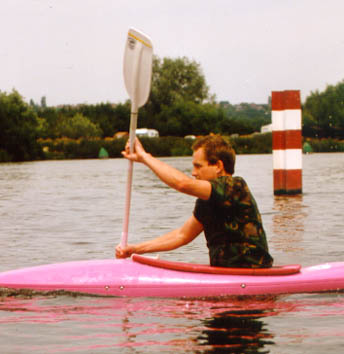 |
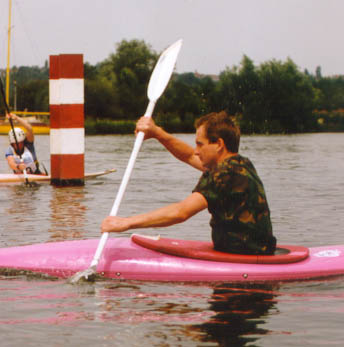 |
| Frame 1. Right (control) paddle in water | Frame 2. Left (non-control) paddle in water |
By using tracing paper overlays it is possible to study how much the arm moves up and down (the arm movement angle) during the paddle stroke cycle.
|
|
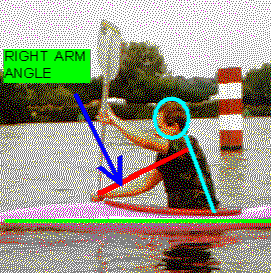 |
Fig 2.a.
The red line shows the position of the right (control) arm when the right blade is in the water at the most powerful part of the stroke. If a similar tracing is made to show the right arm position when the left blade is in the water, then the ARM MOVEMENT ANGLE of the control arm can be measured (see figure 2.b below) |
|---|---|
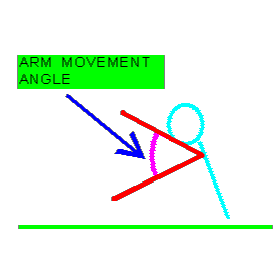 |
Fig 2.b.
Plot of ARM MOVEMENT ANGLE for a Stunt Bat paddler. I found that when paddling a Stunt Bat on flat water my right arm moved up and down through approximately fifty degrees during the paddle stroke sequence (i.e. an Arm Movement Angle of fifty degrees). |
Being right hand controlled, my right wrist is straight when the right blade is in the water. When I bring the right arm up to insert the left blade, my arm will move through fifty degrees, therefore the paddle shaft will be rotated through fifty degrees by my arm action alone.
If I was to use paddles with fifty degree feathered blades, the left blade will be automatically aligned with the water and ready for a stroke with both my wrists remaining straight.
If I were to use ninety degree feathers I would have to rotate the shaft an extra forty degrees with wrist action in order to get the left blade square in the water.
In the photographs shown I have been using forty five degree feathered blades. In this case the fifty degree arm action twisted the shaft five degrees too far for the blades, and I had to use my wrist to compensate for this. Careful study of the right wrist in Figure 1. frame 2 will show that it is bent down by five degrees to keep the left blade square in the water. With a ninety degree feather blade the wrist would be noticeably bent up.
If this theory is correct, then in order to minimise wrist distortion, the feather angle in use should exactly match the degree of movement of the control arm (the arm movement angle) during the normal paddling stroke.
This explains the differences in the feather angles currently in use. Different types of boat have different hydrodynamic properties (drag, speed, turning speed, veer etc.). Each type of boat requires a different paddling style, and needs a different feather angle.
This wrist action consideration is also important when teaching novices. With ninety degree feathers a novice has to learn to move both the arm and wrist to get a good paddling action, and the movement needs to be carefully coordinated. Any instructor knows how difficult it can be for some novices to acquire this skill.
If we give novices paddles with the correct feather, there is no need for them to learn to twist the wrist up and down in each paddle stroke. Their arm action would automatically line up the paddle blade and removes this coordination problem. Fifty five degrees would be a good angle for novices, and the best angle to use for general purpose recreational paddles on the retail market.
In my own experience I have used many different blade feather angles. I found I could adopt to the new angle within minutes. Forty fives are excellent for white water playboating, being noticeably less tiring to use, and very easy to switch from side to side for stern rudders when surfing. The only problem came when rolling. The unusual feel and angle caused a few swims until I spent time in some pool sessions on re-learning to roll with the new feather. Sixty degree feathers are easier to adapt to, but not as fast or responsive.
I would strongly recommend to any paddler that you switch to a smaller feather angle. If you cannot be bothered with the hassle of changing then try this simple experiment with your paddles.
In the good old GP days you chose your paddle length by reaching over the top of the paddle as in diagram 3. This gave you a good length for a mix of white water playing and touring in a four metre boat.
| fig.3 Estimating Paddle Shaft Length for a Standard GP (Four Metre) Kayak | |
|---|---|
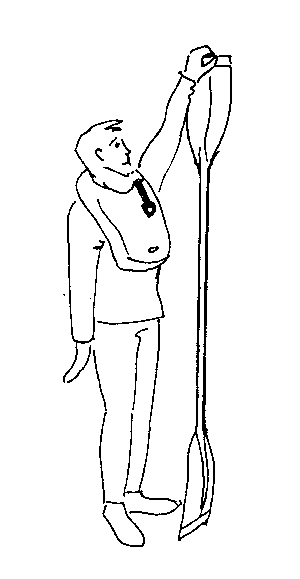 |
This techniques works for boats of a four metre length, and adjustments need to be made for boats which are longer or shorter than four metres, and which have different characteristics of speed and drag |
Modern playboats need a shorter shaft than this "standard length", both because the boat is shorter, and the sprint/drift paddling style needs a short shaft to allow a very fast stroke rate during sudden acceleration. Racing boats by contrast need a longer shaft.
Perhaps we could advise modern paddlers on shaft length by developing a graph as in figure 4.
| fig.4 Adjustment to Shaft Length depending on Kayak Waterline Length | |
|---|---|
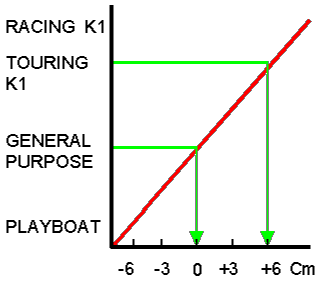 |
This graph shows the number of centimetres to be added or subtracted to the "Standard Length" (see fig. 3 above) to find the shaft length to match both you AND your boat. |
Measure your shaft "Standard Length" with the normal reach-over-the-top technique (figure 3), then look at the graph to find out how many centimetres to add/subtract depending on the style of boat in use.
For example if my standard length is 208cm, I would need a 215 cm touring kayak paddle (208 plus 6), and a playboat paddle of about 202cm.
The results quoted are based on a very low statistical sample (the five kayak paddles standing in the corner of my bathroom) so do not put a lot of trust in them. I think the theory is correct however. Finding the exact figures (perhaps a couple of thousand samples measured at a variety of competitions and tours) would make an excellent and valuable Sports Science research project. Any takers?
The one aspect of paddle design that is rarely discussed is the area of the blade. They all seem to be roughly the same size.
This shape evolved through trial and error to be the right size for reasonably fit adult males performing a mix of slalom and WW playboating in GP kayaks. If you do not fit that category, however, why should you be forced to use that blade size. There is no law which says they must be made that way.
If you have lower physical strength (women canoeists or teenagers) then you could need a smaller blade area. Paddling a heavy boat (perhaps a loaded sea kayak) could also be a reason to change down in size. If you are in these categories and get unusually tired after a days paddling this could be worth looking at.
Reducing the blade area (as well as the feather) may also be an option if you are a recreational paddler prone to overuse and stress injury. Extreme sprint/drift kayaking also needs a smaller blade area. Squirt boaters do not use squirt stick paddles simply for fashion (well perhaps they do). Squirt sticks match the boats hydrodynamically. Surf ski paddlers have discovered this as well. Please don't ask me how to find a paddle with a reduced blade area. Ask the manufacturers or your local friendly trader.
The final choice is cranks. Most people get by perfectly happily with straight shafts, but for a few people a cranked paddle can be extremely beneficial.
The quoted reason for how they work seems to be that by cranking the shaft, the wrist is kept straighter, and that this reduces the strain on the forearm and hence improves performance and reduces tiredness. I am not sure if this theory is correct. I think that one important factor is in the tension in the tendons that run from the fingers, across the wrist, and connect to muscles in the forearm (figure 5).
If you want to hold the paddle firmly in turbulent white water, then the fingers have to be clamped tightly onto the paddle shaft, and this clamping pressure comes from tendons which run through the wrist to muscles in the forearm. These tendons have to be kept tight to clamp the fingers onto the paddle.If the paddle shaft is cranked (or has a big diameter, or has a high friction foam grip) this allows more rotational leverage over the shaft, and allows the same amount of control with the tendons less tight, and the wrist therefore less stressed. I think this is the important factor, not the straightness of the wrist.
| fig.5 Tendon Stress across the Wrist | |
|---|---|
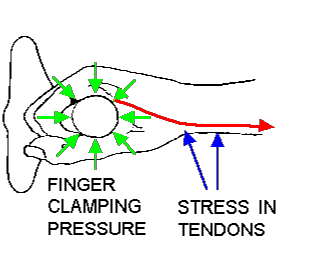 |
To hold the shaft tightly, the fingers are clamped down onto the shaft
by the pull of the tendons, which run along the wrist and forearm.
Anything which encourages less finger clamping force on the shaft (large diameter shafts, high friction foam grips, cranks) reduces the tendon pull, and reduces the stress on the wrist joint. |
The other factor is the style of crank. Recreational paddlers use "leading" cranks (called "modified cranks" by Lendal). With this design the hand leads the paddle which lines itself up in the direction of pull. This is exactly the same geometry as a supermarket trolley wheel or a castor on a sofa. It automatically lines up in the direction of pull without any twisting force from the hand.
These cranks give immense paddle stability and reassurance when being trashed in a river. They are wonderful paddles to use if (like me) you are beginning to creak in the joints and getting a bit twitched about mega-stoppers.
| fig.6 Types of Crank Geometry | |
|---|---|
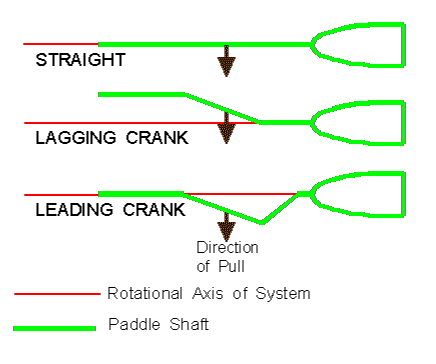 |
Leading cranks are torsionally stable,
because the hand pulls the blade through the water.
Lagging cranks (although kinder on the wrist tendons than straight shafts) are torsionally unstable |
Slalomists seem to use normal cranks (which I call lagging cranks because the pull from the hand is behind the shaft axis). These would appear to be torsionally unstable, but they are obviously popular so there must be some reason why they work. I wish I knew what it was.
When using modified (leading) cranks, take about twenty degrees off the blade feather angle normally in used for straight shafts for the same type of boating. I would recommend 45 degrees for slalomists and tourers, and about 25 degrees for WW playboating.
For todays average recreational paddler it should be sufficient simply ensure that the shaft length and feather angle match your body size, boat and the type of canoeing you do.
Most people cope without cranks, but they could be worth looking at for high performance paddling, reducing stress for long distance journeys, or for those prone to stress/overuse injury.
It is a pity that a choice of blade sizes is not easily available. I believe that the inability of paddlers with lower than average body size, strength or stamina to obtain a paddle blade with a suitable surface area is a major obstacle to current development in priority group canoeing.
It is now standard practice to produce popular kayaks and equipment in a range of sizes, to allow paddlers to choose the optimum equipment for their body weight and style of paddling. Can a choice of paddle blade sizes please be the next development.